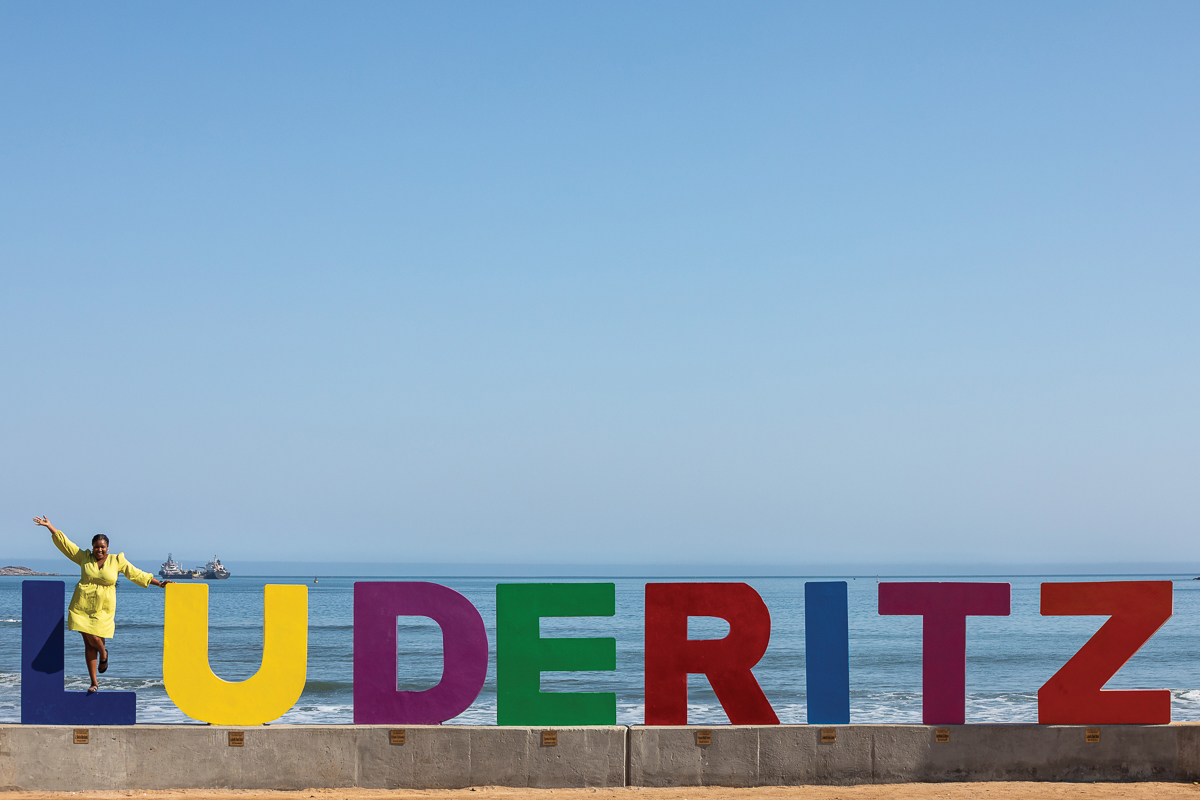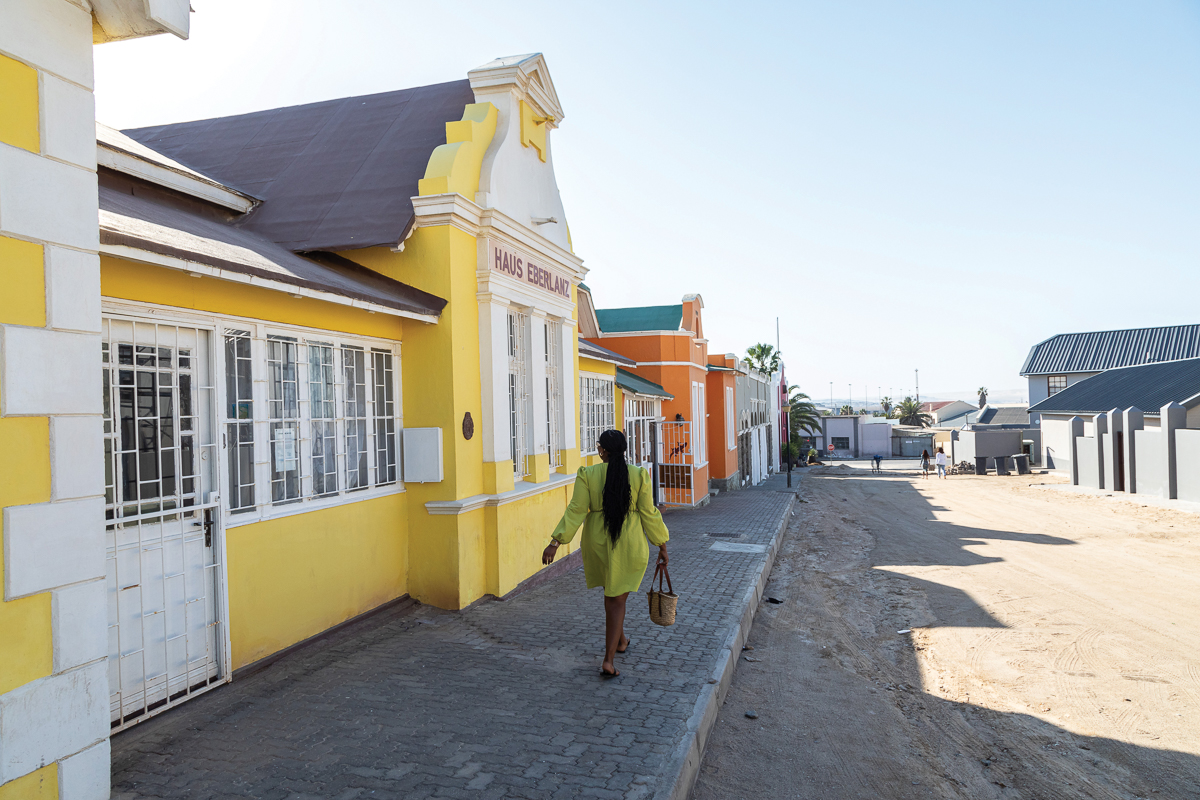

Oysters, architecture and history: Uncover the charm of Lüderitz
Small towns in Namibia have a special allure. They often exist as a result of some or other historical irony, consolidated from one generation to the next. Be it the central melting pot of rural life as in the case of Rundu, fruitful agriculture in its surroundings like Omaruru, or for a productive long-standing harbour like in Lüderitz – each tiny town develops a distinct character.
Text Charene Labuschagne | Photographs Le Roux van Schalkwyk
From the Spring 2023 issue

Because this country is jam-packed with noteworthy tourist destinations, it comes as no surprise that many small towns lie at an intersection. They exist entirely in their own commercial and cultural right, as well as being a stopover for travellers visiting said attractions. These, in my opinion, are the very best of tiny towns. Locals go about their business, and you, the visitor, get to taste a smattering of their existence. Tomorrow your journey continues elsewhere, and the town embarks on its everyday life as always.
Lüderitz is the designated destination for travellers wishing to visit the famed Kolmanskop ghost town. And while the sand-filled historic homes of Namibia’s first diamond tycoons remain an awe-inspiring sight, this small town has a whole lot more up its sleeve.
First, a history lesson
Turning the hands of time back to 1487, Portuguese explorer Bartolomeu Dias first laid eyes on the area and named it Angra Pequena (small bay), leaving his mark with a stone cross. Over the centuries that followed the region drew adventurers and scientists in search of minerals, but it was only in the early 19th century that Lüderitz truly found its calling as a bustling trading post. Whaling, seal hunting, fishing and guano-harvesting enterprises thrived on this section of the coast.
In 1883, a settlement officially took shape when Heinrich Vogelsang secured the land for Adolf Lüderitz, a German entrepreneur. The area was renamed Lüderitzbucht in his honour after his disappearance during an attempt to sail from the Orange River mouth back to his settlement. With the discovery of diamonds in 1908, Lüderitz experienced a dazzling boom, but fortunes changed as a result of WWI when Germany lost control of its colony in 1915, and South Africa took over. The diamond rush shifted southward, and the former significance of Lüderitz gradually waned. It became a quiet coastal town where echoes of its vibrant past linger to this day.
Where to stay
Lüderitz boasts several accommodation options, the most prominent being the Lüderitz Nest Hotel. Situated on the outskirts of town with great views of the Felsenkirche as well as the ocean, the Nest offers classic, comfortable rooms, a swimming pool and it serves a fantastic breakfast.
Krabbenhöft & Lampe makes for a unique self-catering stay in the centre of town. The building, now a national monument, was one of Lüderitz’s first trading houses. With wooden floors, high ceilings and ample character it is an authentic accommodation facility.
Kratzplatz, centrally located and also in a historic building, is a bed & breakfast. Quaint and quirky, the accommodation offers everything a guest might need, from WiFi to secure parking, while maintaining a laid-back, no frills kind of vibe.
Where to eat, drink and be merry
Essenzeit is located at the Lüderitz waterfront with ample indoor and outdoor seating. Accompanied by a great view of the bay, the menu offers something for everyone, including pizza, burgers and breakfast. Enjoy an ice cold local beer and dive into the sensational seafood platter while admiring the monohulls and catamarans that bob calmly in the bay.
Diaz Coffee Shop is a great lunch spot, which serves wholesome and affordable dishes from toasted sandwiches to loaded fresh fish meals. The restaurant is divided into two sections, one with an old-school coffee shop atmosphere and the other decorated with authentic nautical paraphernalia like buoys, oyster cages and faded green rope. Try fresh oysters with Tabasco and a lemon wedge.
Portuguese Fisherman is a newer eatery, with sheltered outdoor seating and ample more inside perfectly suited to the windy, yet sunny town. The menu is limited, but this is just the place to tuck onto calamari and crayfish, paired with white wine and adorable marine-inspired decor.
Barrels is the local hang-out spot favoured for its no-nonsense menu of pizza and the chef’s special, which is a three-course dinner and always something different. Buchters, as the locals are fondly called, gather there for after-work drinks at the bar or around tables fashioned from wine barrels. The place is small and dimly lit, but consider this a pro rather than a con – it oozes atmosphere.
What to do, see and experience
Getting the lay of the land is always an essential first step when visiting a new destination. Luckily, Lüderitz is very pedestrian-friendly. Almost everything is at a comfortable walking distance (small towns rock for this reason). After checking into your accommodation, I recommend embarking on a walking tour of the town to familiarise yourself with the shops and restaurants at your disposal. A big, fat perk of walking through Lüderitz is the architecture of bygone years that must be marvelled at from up close. Most of the historic buildings’ facades show the year when they were built. Otherwise, little information about their origins means you can colour in the picture with your imagination.
A short 25-minute drive takes you to the Lüderitz peninsula where a replica of the Diaz Cross stands sentinel over a rocky hill and the rough Atlantic crashing against its base. Climb the concrete steps to the top, take in the view and snap a picture with the cross. Be warned, it gets quite windy there! Once descended from the viewpoint, I recommend having a hot chocolate or tea at the Skip Skop coffee shop that overlooks the quirky campsites on the peninsula. A lighthouse with classic red and white stripes completes the picture.
Local stakeholders in the tourism industry recently erected a brightly coloured LÜDERITZ sign, inviting visitors to grab a few Insta-worthy pictures. Concrete letters in technicolour hues are cast on a low wall, with the perfect backdrop of the calm waters of the bay and harbour. Not only is this a great place to mark your visit to the Bucht, but locals have adopted it as their designated sunset spot. Grab a few refreshing drinks from a shop in town and sign off a day in Lüderitz while gazing across the ocean.
Essential to the Lüderitz skyline and any visitor’s itinerary is the Felsenkirche, completed in 1912. Translated from German the name means rock church. The Felsenkirche’s doors open for visitors at 5pm, just in time for a ray of sunlight to strike the beautiful stained-glass windows and illuminate the church in a mosaic of colour. Old-school wood benches and a classic domed altar complete the experience. Religious or not, it is something truly spectacular.
Last, but certainly not least: Kolmanskop. The appeal of Lüderitz’s rich history is tethered to the rise and fall of this settlement, which sprung up after the first diamond was discovered in the vicinity in 1908 by railway worker Zacharia Lewala. Kolmanskop was created out of the dust. Wealthy residents enjoyed amenities like a ballroom, power station, an ice factory and a hospital which boasted the first X-ray equipment in the southern hemisphere. The now eerily empty and dune-filled buildings can be explored at your leisure, or with a guide.






